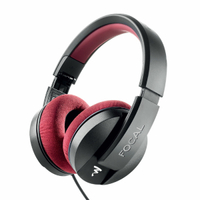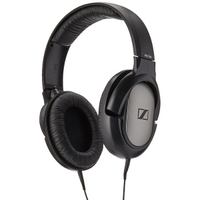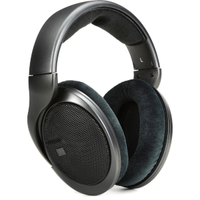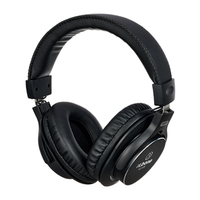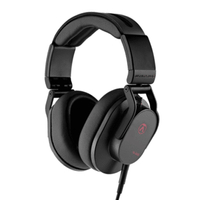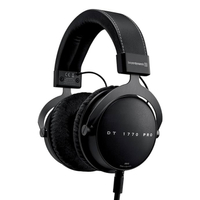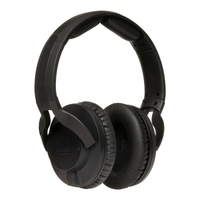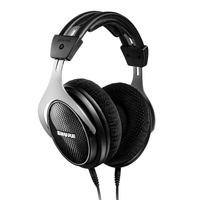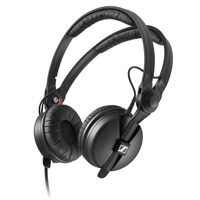Best studio headphones for music production and mixing 2025: tested by experts
We’ve tested and reviewed a huge range of headphones for music production. These are our tried and trusted choices – plus your FAQs answered
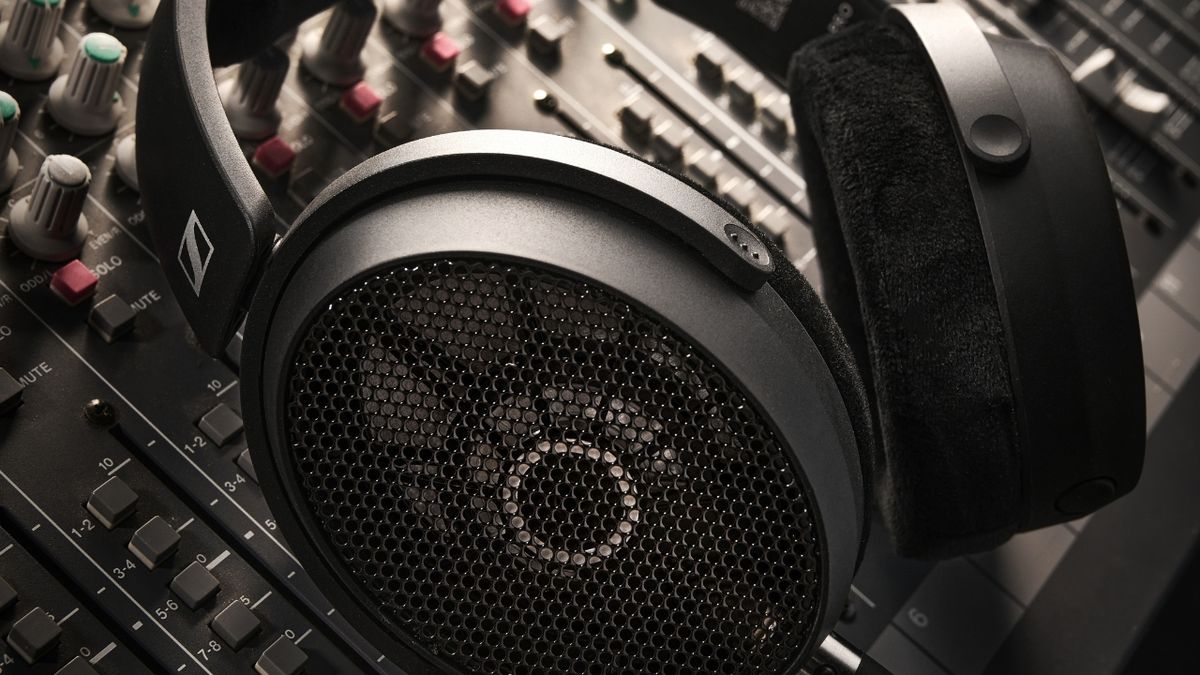
Traditionally when setting yourself up for recording you'd try and get the best room treatment and monitors possible. But this is heavy on your budget, and you can't take it with you when you need to mix on the go. In the modern age, you'll get much further intimately learning a pair of the best studio headphones, and using these as a core perspective for your mixes.
Lots of producers spend a lot of time with their headphones, and when you take into account things like Sonarworks which can flatten the response of your headphones, this can make your mixing decisions even better than just using a pair of studio monitors alone. The majority of your audience will be doing their listening on headphones, so it makes sense to do some portion of your mixing on them too.
There are a lot of factors that go into making a great studio headphone that goes beyond just the sound. They need to be comfortable and durable, especially if you want a pair for day-to-day music listening duties too. The pair that ticks all of these boxes for us is the Beyerdynamic DT 900 Pro X. They're not cheap however, so if these are a little too spenny for you, then you should check out the Sony MDR-7506s. Good enough for Andrew Scheps, this cheap pair of studio headphones are well known for their excellent durability.
We've rigorously tested every single model in this guide to ensure they're suitable for the task of mixing and mastering, as well as being general listening headphones. We've also sorted them by use case to make it easier for you to make a decision, and we've included a specs comparison so you can put everything in the guide head-to-head. If you want to learn more about studio headphones before you buy, then make sure to check out our FAQs.
Our top picks
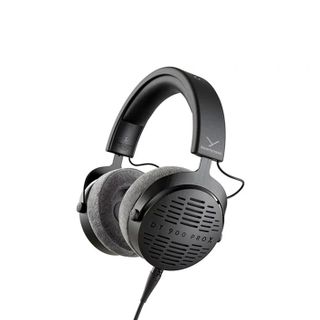
They feature an updated driver design, detachable cables, a sleeker, more modern look and one fixed impedance rating, making them suitable for a more diverse range of applications, although specifically they're some of the best mixing headphones on the block.
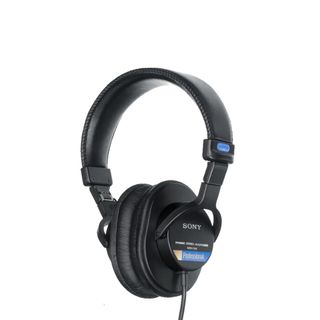
The quintessential workhorse headphones beloved by Andrew Scheps, the Sony MDR-7506s are available below the $/£100 mark, making them incredible value for money. Durable and comfortable, they provide a neutral sound great for mixing.
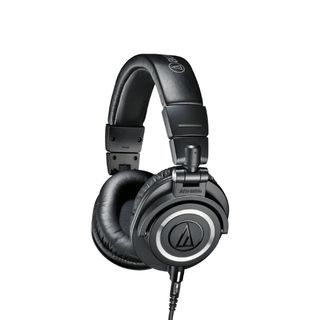
If you're looking for your first pair of studio headphones, we'd go with the Audio-Technica ATH-M50x. Great value for money whilst delivering excellent sound quality, they're a little heavy in the bass end of the spectrum, but that also makes them fantastic for regular listening duties.
Best overall
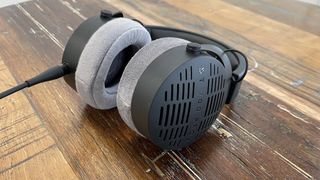
Specifications
Reasons to buy
Reasons to avoid
✅ Buy if you want great headphones for mixing: These have an incredibly neutral sound, meaning you won't overcompensate for anything - you'll hear what you mix.
❌ Avoid if you are a fan of portable headphones: These are among the largest here and not entirely practical to take out and about.
Overview: These all-new Beyerdynamic 'phones bridge the gap between, but do not replace, the other Beyer models in this round-up. They feature an updated driver design, detachable cables, a sleeker, more modern look and one fixed impedance rating, making them suitable for a more diverse range of applications. These upgrades are reflected in the higher price point, coming in at roughly $/£100 more than the older PRO models.
Comfort: The 900’s are probably the most comfortable full-size cans we’ve tried, but isolation from external noise is not the greatest, as you’d expect from open-back cans.
Audio performance: As the open-back member of the squad, the DT 900 PRO X is Beyer’s suggestion as a weapon of choice for critical listening and mastering. They're also some of the best mixing headphones on the block. There's also a closed-back version, the 700 PRO X, that retails for the same cash.
Sound-wise, they have a flattish profile delivering each frequency range without bias or favour. Your ears will be privy to a refreshingly accurate portrayal of what’s actually there, exactly what you want from something that’s marketed as a studio reference monitor headphone. They will do an excellent job of revealing any issues in your own projects, quick to shine a light on any problem areas that may need attention.
Read our full Beyerdynamic DT 900 Pro X review
| Test | Results | Score |
|---|---|---|
| Comfort | The most comfortable we've tried | ★★★★★ |
| Audio | Accurate, flat response | ★★★★★ |
Best budget
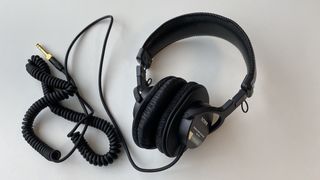
Specifications
Reasons to buy
Reasons to avoid
✅ Buy if you want comfort and a practical design: And these are among the cheapest cans here to offer a great, workhorse performance.
❌ Avoid if you want some more modern headphone tech: Things like cooling gels, and shorter, lighter cables aren't an option here. These have a more old-school appeal.
Overview: The Sony MDR series has been around for years and has a solid studio pedigree, borne out by many decades of daily use in the recording and broadcast sectors worldwide. The current incarnation, the MDR-7506 is a brilliant combination of comfort, practicality and value.
Comfort: In our experience these are extremely comfortable to wear for extended periods, but we'd appreciate a little more padding on the headband, which can be a little headache-inducing over time.
Audio performance: These studio headphones are designed to expose what’s wrong with a recording rather than what’s right. On a par with other cans costing twice as much, in action the sound is punchy and clear throughout the spectrum (with a moderate boost in the upper mids), while managing not to be overly-flattering.
So all in all the fact that these workhorse cans are available for well under a hundred dollars/pounds is not to be sniffed at.
Read our full Sony MDR-7506 review
| Test | Results | Score |
|---|---|---|
| Comfort | Great for the price, but we'd prefer a more padded headband | ★★★★☆ |
| Audio | Punchy and clear | ★★★★☆ |
Best for beginners
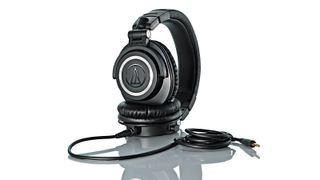
Specifications
Reasons to buy
Reasons to avoid
✅ Buy if you want a set of headphones to take on the move: These will fold up for a variety of occasions, from DJ-ing to remote sessions.
❌ Avoid if you want to hear all of your high frequency detail in all of its glory: They lacked some sparkle up there in our tests.
Overview: The reissued M50 ('x’ = detachable cable) is a popular model across the audio world, competing directly with big players like Beyerdynamic and AKG.
Comfort: They are very comfortable, fold and bend in all the right places, and are relatively light at just 285g.
Audio performance: The sound quality is good overall, though in our tests they did shy away from a detailed, airy HF region. The mids are clear and forward, while the bottom-end extends down without any peaky resonances. As with all the low impedance designs in this guide (these are 38 ohm), they are easily driven beyond our comfort threshold.
Read our full Audio-Technica ATH-M50x review
| Test | Results | Score |
|---|---|---|
| Comfort | Lightweight and flexible | ★★★★☆ |
| Audio | Ideal for mixing | ★★★★☆ |
Best open-back
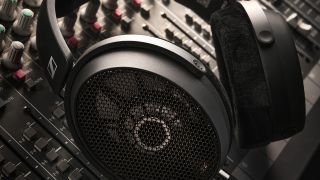
Specifications
Reasons to buy
Reasons to avoid
✅ Buy if you want the best headphones for mixing: This is a premium pair of cans specifically designed for mixing and mastering, making them perfect for mixers.
❌ Avoid if you're on a budget: They're also incredibly pricey, which means if you're on a budget you're best off looking elsewhere.
Overview: The top of the range of Sennheiser's 400 Series, the Sennheiser HD 490 Pros are our top choice for mixing and mastering. With an open-back and over ear design, they include two different pairs of earpads, a removable headband, and a 1.5m, removable cable.
Comfort: You get two different flavours of earpad, with one velour set and one fabric set, which is an interesting one for studio headphones. This means you can select your preferred feel, which is a nice bit of customisation that will suit users differently.
The velour headband is also removable, and the plus model features a separate fabric headband, but overall we found it to be really comfortable for long listening sessions.
Audio performance: The first words that came to mind when using the HD 490s was 'neutral' and 'balanced'. The fact they're designed for mixing is clear from the off, with no bass hype we could determine. The soundstage is really good, giving you nice separation of stereo sounds all across the left/right spectrum.
The two different earpads are supposedly designed to deliver a different tone to the headphones, with the velour pads being for production work with slightly more bass, while the fabric pads are for mixing with flatter bass and a stronger midrange. To be honest, the difference was minimal in our opinion, but we still like the option to switch between the two.
Read our full Sennheiser HD 490 Pro review
| Test | Results | Score |
|---|---|---|
| Comfort | Great for lengthy sessions | ★★★★★ |
| Audio | Balanced and neutral | ★★★★★ |
Best closed-back
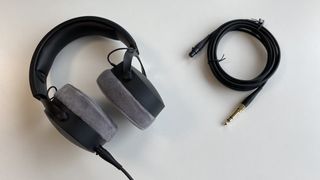
Specifications
Reasons to buy
Reasons to avoid
✅ Buy if you need all-round headphones that, like many in our guide, deliver a great sound, comfort and a fantastic design.
❌ Avoid if you don't have the cash: There are cheaper options like the 770 Pro, which lacks a few features, but is nearly half the price.
Overview: An upgrade both price and features-wise from the DT 770 Pro, the DT 700 PRO X features an updated look, even squishier earpads and improved sound thanks to a new STELLAR.45 transducer design with a faster response.
Comfort: One of the more comfortable sets of cans we’ve tried over long periods, those large velour earpads are like wearing a sofa on either side of your head, whilst still giving us enough ventilation and breathability on those warmer sessions. The spring steel headband is memory foam-lined, which helped during longer sessions.
Audio performance: The new transducer design enables a detailed transient response and a reliable sound that’s distortion-free even at high sound pressure levels. Since the 770 PRO X is available with a single 48Ω impedance rating, these are a worthwhile pick for both studio and everyday applications. That and the fact that the earpads, headband pad and cables can all be easily replaced - you get a choice of two cables already in the box - make these a solid choice if you want to level up from the 770 Pro.
Read our full Beyerdynamic DT 700 PRO X review
| Test | Results | Score |
|---|---|---|
| Comfort | We like the velour and memory combo | ★★★★★ |
| Audio | Great for volume | ★★★★★ |
Best for comfort
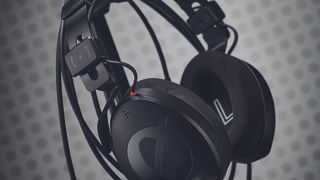
Specifications
Reasons to buy
Reasons to avoid
✅ Buy if you want comfortable, stylish headphones: They sound equally good in the studio as they do connected to your hi-fi, too.
❌ Avoid if you want flexible and compact cans to take anywhere: They don't fold up like many headphones do for storing, nor is there a hard case.
Overview: Røde has been in the market of making more than just microphones for a good while now. With mixers aimed at podcasting and small audio interfaces for content creators, it is little wonder the company should now develop its first pair of headphones, the over-ear NTH-100s. Australian firm Røde is known for offering quality at competitive price-points, and these debut headphones are no different.
Comfort: The NTH-100s are innovative in their design, and offer clear and faithful sound, comfort and quality construction throughout. We love the soft Alcantara and memory foam pads. What's more, the earcups are shaped like the human ear, which we found reduced pressure in the usual areas.
Audio performance: Much attention has gone into tuning the earcups - which we found have a distinctive, elongated shape for a more natural fit - and drivers so that they can deliver a fine balance of focus and width in the soundstage. We found them to perform well in every studio sceanaio we tested them in, including monitoring, mixing, and mastering. Most importantly, there was barely any additional noise at higher volumes.
These are some of the best headphones we’ve tested recently and also position highly in our guide to the best studio headphones under $200/£200.
Read our full Røde NTH-100 review
| Test | Results | Score |
|---|---|---|
| Comfort | Innovative shape and plush materials | ★★★★★ |
| Audio | Focus and width | ★★★★★ |
Specs comparison
Also consider
The above studio headphones are for us, the ones you should be spending your money on. They aren't the only ones we've reviewed however, so if you didn't quite see what you were looking for above, here is a selection of other music production headphones we've reviewed.
Focal Listen Professional
The Focal Listen Professionals are exactly what they say on the tin; ideal for both listening and pro duties. This puts them firmly top of the class in the all-rounder category.
★★★★★
Read more: Focal Listen Professional review
Sennheiser HD-206
If you’re in the market for a cheap pair of headphones for everyday studio use, you need to check out the Sennheiser HD-206. Bearing the well-respected Sennheiser name on the headband, the extremely tough and durable HD-206s are comfortable to wear for extended periods.
★★★★
Read more: Sennheiser HD-206 review
Sennheiser HD 400 Pro
Unlike some closed-back headphones that overblow bass frequencies due to the build-up of pressure, the HD 400s allow for natural airflow, which not only improves the soundstage but also adds to the comfort when wearing them for long periods.
★★★★½
Read more: Sennheiser HD 400 review
the t.bone HD 515
Although not suited to mixing, if you’re simply after a well-made budget headphone for recording this could be ideal. We found them to be solidly made, look good and offer excellent value. In our tests the closed-back over-ear design delivered reasonable passive noise cancellation. In a recording environment this means there’s not going to be bleed into any close mics, and from a performer perspective much of the room sound is successfully kept at bay.
★★★½
Read more: the t.bone HD 515 review
Austrian Audio Hi-X65
These cans deliver excellent, balanced sound that remains neutral yet highly detailed, coupled with solid build quality, all leading to what we found to be an enjoyable listening experience whatever the setting. Foldable construction for added portability, twin detachable cables of different 3-metre and 1.2-metre lengths to suit a variety of tasks and soft, slow-retention memory foam earpads for extended comfort all add to the appeal.
★★★★½
Read more: Austrian Audio Hi-X65 review
Beyerdynamic DT1770 PRO
Designed specifically for mixing, the DT 1770s are exceedingly well-balanced across the audible spectrum. We found the mid-range to be free from audible phase shift, allowing the clarity essential for professional use. The sound stage projected into your head is as pleasurable as it is revealing. They provide a highly detailed view into your audio, from left to right, front to back, and even into the corners.
★★★★½
Read more: Beyerdynamic DT1770 PRO review
KRK KNS 8402
KRK are best known in music production circles for their Rokit monitors, which have become ubiquitous in bedroom studios. While their headphones are lesser known, they’re impressive for their price nonetheless. Sonically, we found the KNS 8402s to have a beautifully smooth high frequency response, very usable low frequency extension, a slightly subdued lower midrange and a present but not hyped upper midrange.
★★★★½
Read more: KRK KNS 8402 review
Shure SRH1540
In practice, the premium model SRH1540’s did not disappoint us, delivering excellent acoustic performance, comfort and durability to professionals and audiophiles alike. Offering an expansive soundstage and immaculate transient detail across the board, with clear, extended highs and warm bass in a lightweight alloy and carbon fibre architecture, the 1540’s are topped off with swish Alcantara leather earpads for supreme comfort and sound isolation.
★★★★★
Read more: Shure SRH1540 review
Sennheiser HD-25
Another long-standing studio favourite of ours, HD-25’s are acclaimed by pros for their ability to handle high sound pressure levels and deliver excellent sound reproduction. A stalwart of the DJ booth thanks to their split headband, rotatable earpieces and reputation for durability, the HD-25s delivers punchy and accurate sound in a lightweight yet robust package.
★★★★½
Read more: Sennheiser HD 25 review
FAQs
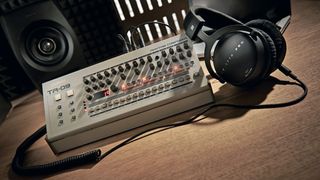
What types of studio headphones are there?
When it comes to studio headphone design, there are three options to consider: Closed-back on-ear, open-back on-ear, and in-ear.
Closed-back headphones are best for recording applications as they fully enclose the ears, and the padding around the ear helps to avoid spill; which is unwanted traces of the backing track leaking out and ending up on your recording. The padding also provides an additional layer of comfort.
Spill can be a problem if your performer likes to monitor with some volume - so when recording performers with microphones - this type of headphone is definitely the route to take.
Open-back headphones tend to be lighter and are therefore a bit more comfortable to wear for longer periods, but they’re generally not as common. They present a higher risk of audio spill, so are more suitable for programming and mixing duties, rather than straight recording. They also don’t block out external noise as effectively as closed-back options, so there are definitely some compromises to be made here.
In-ear monitors (aka IEM’s), meanwhile, are usually reserved for on-stage monitoring, unless they’re extremely high quality, in which case they can be suitable for use in a studio environment. In-ears wouldn't be our first choice in this instance, but if you're splitting your time between stage and studio and only have budget for one set then in-ears could be the way to go.
Do I really need studio headphones?
Like the name implies, anything branded a studio headphone will have been designed especially for use in a recording studio setting, with particular focus on the tasks of tracking, programming, editing and mixing. The type of headphone you choose will be dependent on which of these tasks you’ll most need them for. An open-backed design is more prone to spill than a closed-back pair, so open-backs tend to be more useful when mixing and editing as opposed to tracking, since any spill can be picked up on microphones.
Closed-back designs are a bit more versatile as they can usually be applied to all studio-related tasks. Studio headphones also usually have less of a smiley curve response than ordinary hi-fi headphones, which often exhibit enhanced low and high-end response designed to flatter the sound and improve the everyday listening experience - not necessarily what you want from a pair of studio cans.
What's the difference between studio headphones and normal music listening headphones?
One question you might be asking is why the distinction between regular and studio headphones - why can’t I just use any old set of cans for music production? Ok, that’s technically two questions, but the answer to both is the same - most headphones that are produced for ordinary everyday listening or gaming have an inherent boost somewhere in the frequency range to enhance the listening experience, usually making things sound better by boosting the bass and treble frequencies.
In a studio headphone, this isn’t such a good idea, as you want your cans to accurately reflect the music you’re creating, rather than making it sound better than it actually is. For this reason, dedicated studio headphones will generally have been designed to exhibit a flatter frequency response than most regular cans, so that tracks made using them will sound better when played back on a wide range of systems.
You may have a pair of regular Bluetooth headphones and wonder if you can produce using those too? We weigh up the pros and cons of using Bluetooth headphones to produce music in this article.
Do I need an amp for my studio headphones?
One key aspect of headphone design that may influence the route you take is impedance. Good ‘impedance matching’ will help your headphones work more effectively, so here you need to consider what type of gear you’ll be plugging them into. Let us explain a little deeper…
High-impedance headphones are designed for studio environments like a band recording setup, where you might find multiple sets of cans plugged into a headphone splitter box that’s receiving a high-level input signal from one source, eg. a professional headphone amplifier. Meanwhile, low-impedance headphones are designed to be plugged directly into a single source, like a hi-fi stereo amp, audio interface or mobile phone, so they’re able to generate sound more efficiently from the lower-level input signal these devices put out.
Most studio headphones on the market today have a low enough impedance that they can happily be plugged into the outputs of regular devices such as mobile phones and laptops. Some models, however, such as the Beyerdynamic DT770, are available at a variety of impedances; the higher impedance models are intended for use in a studio setting where they’ll need to be driven by a separate headphone amp in order to perform at their best.
Generally, high-impedance headphones require higher signal levels to produce the same output level of low-impedance headphones. So broadly speaking, the higher a headphone’s impedance rating, the more ‘pro’ it was designed to be. We’ve included the impedance rating with our best studio headphones choices in this guide so it’s clear what you’re getting.
What does headphone frequency range and response mean?
The frequency range of your headphones is a good indicator of their quality as it shows the breadth of tones they can reproduce, from bass frequencies measured in Hz up to treble measured in kHz. The wider this range, the better, as it shows your headphones are capable of reproducing more of the range of the music you are playing through them. Generally the range of human hearing is 20Hz to 20kHz with the upper figure lowering as we get older.
The frequency response is this range plotted against the output of the ‘phones in dB on a graph, and is also important as it will show any colouration of the headphones i.e. where they might be boosted. Some cheaper sets, for example, might have a boost in the lower frequencies to give them a warmer, deeper sound. With music production, this is not good as you will end up removing bass in your mix to compensate, resulting in your music sounding bass light on other playback systems.
What you want in your mixing headphones is a flat frequency response to accurately reproduce your music, without colouration. The frequency response is therefore quoted with the range of frequencies (40Hz to 20kHz, for example) and a +/- figure in dB at the end, which indicates the variation in signal level over that range. The smaller this is, the better (look for something around +/-3dB or less).
Which brands make the best studio headphones?
The likes of Audeze, Focal and AKG make some of the best high-end headphones, expensive reference cans used in mastering that often set you back well into four figures. However, these are really for professional engineers and out of reach of most of us producers. For mixing duties, most of these companies do more affordable models that are ideal for home studio set ups, and Audio-Technica, Beyerdynamic, Shure, Sennheiser and newcomers Austrian Audio are also reliable brands that deliver the goods.
How much should I spend on studio headphones?
Like most audio products, the sky can be the limit with studio headphones in terms of price and, as we’ve said elsewhere in this guide, you can pay four figures for a set of cans with a super flat frequency response that will deliver the precision in playback you need for mixing and mastering. That said, as with studio monitors, the technology and design of studio headphones has been improving in recent years, and prices have been falling. So, as the range of phones we have on test shows, you can pay as little as just under $/£100 for a decent set, and certainly no more than $/£400, with the average sitting somewhere around $/£200-250.
What's the difference between wireless and wired headphones?
When it comes to headphones aimed at home listening, gaming or other day-to-day uses, wireless Bluetooth connectivity is becoming a pretty much standard feature. So is it time to invest in a set of Bluetooth headphones for the studio too?
The short answer is no. You’ll notice that our guide here largely avoids wireless headphones, and the simple reason behind that is that wireless connections cause latency – i.e. a delay between the sound playing on your computer and you hearing it. For a whole multitude of reasons, tight timing can be key when recording and creating music, so latency is best avoided. Wireless headphones can also hinder the audio quality too.
While the technology is certainly improving, right now we’d suggest relying on wired listening in the studio. That said, an increasing number of headphones now let you have the best of both, with options for both wired and wireless operation, which could be a great option if you’re looking for a pair to use both in the studio and on the go.
We go into more detail in this feature looking at whether it's possible to produce music using Bluetooth headphones.
How we test studio headphones
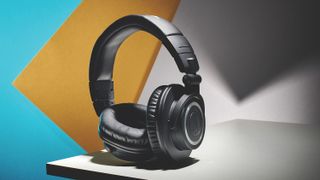
As with studio monitors, we test headphones with a variety of reference tunes – mostly very well produced standards, but some of our own trusted mixes as well. We use these to check frequency response and general overall quality in terms of spatial response and playback, and in terms of how good the 'phones are at delivering a response at low volume levels - the levels you should be mixing at to protect your ears.
For the best studio monitor headphones we also test how good the isolation is. For mixing you might prefer less intrusion from the outside world so you can focus on the main elements in your music, so isolation is a key factor.
The weight and comfort of the phones is also an important consideration, as you'll likely be wearing them for long sessions in the studio (although we obviously recommend taking regular breaks). Most of the time, the lighter the better but how the headphones embrace your head is important. Too loose is obviously not good, but too tight can mean too hot.
Finally, we look at elements such as build quality and durability and any bundled features such as cleaning kits and multiple cable length options.
Read more about how we test music making gear and services at MusicRadar.
Read more:
MusicRadar's got your back
- Spend more time in the booth? These are the best DJ headphones
- The best podcast headphones for your rig
- Best headphones for digital piano: over-ear options for every budget
- Best headphones for drummers: sound isolation from studio to stage
Latest updates
Recent updates
11/11/24: We've added a new product, the Sennheiser HD490 Pro, and given our top picks a reshuffle to better reflect the needs of beginner music producers. We've also added a specs comparison table that allows readers to more easily compare all the different models in the guide.
27/06/24: We've broken down our product entries into more detail, giving you an overview of each product before going into depth on comfort and audio performance - two areas we think are most critical when choosing headphones. We've also streamlined the guide as a whole, making it easier to find the information you need, particularly on a smartphone.
20/03/24: We've added clearer labels to each of our product choices so it's easier to find the right headphones for you. We've also created an 'also tested' section so you can see which other models have been under our microscope lately.
Get the MusicRadar Newsletter
Want all the hottest music and gear news, reviews, deals, features and more, direct to your inbox? Sign up here.
Dave has been making music with computers since 1988 and his engineering, programming and keyboard-playing has featured on recordings by artists including George Michael, Kylie and Gary Barlow. A music technology writer since 2007, he’s Computer Music’s long-serving songwriting and music theory columnist, iCreate magazine’s resident Logic Pro expert and a regular contributor to MusicRadar and Attack Magazine. He also lectures on synthesis at Leeds Conservatoire of Music and is the author of Avid Pro Tools Basics.
- Andy Jones
- Matt McCrackenJunior Deals Writer
